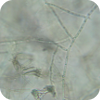Rhizoctonia solani
Host(s)
Disease name
Collar rot, root rot, damping off and wire stem
Description
Rhizoctonia solani (teleomorph: Thanatephorus spp.) is a plant pathogenic fungus with a wide host range and worldwide distribution. This plant pathogen was discovered more than 100 years ago. Rhizoctonia solani frequently exists as thread-like growth on plants or in culture, and is considered a soil-borne pathogen. Rhizoctonia solani is best known to cause various plant diseases such as collar rot, root rot, damping off and wire stem. Rhizoctonia solani attacks its host(s) when they are in their juvenile stages of development such as seeds and seedlings, which are typically found in the soil. It makes sense then this saprophytic pathogen would live and survive in the soil, and attack the part of its hosts that reside there. The pathogen is known to cause serious plant losses by attacking primarily the roots and lower stems of plants and although it has a wide range of hosts, their main targets are herbaceous plants. Rhizoctonia Solani would be considered a basidiomycete fungus if the teleomorph stage were more abundant. The pathogen is not currently known to produce any asexual (conidia) spores, though it is considered to have an asexual life cycle; Occasionally, sexual spores (basidiospores) are produced on infected plants. The disease cycle of Rhizoctonia solani is important in regards to management and control of the pathogen.
(Text and image from Wikipedia, the free encyclopaedia.)
Ensembl Genomes provides access to the genome of 5 strains for this species:

